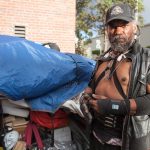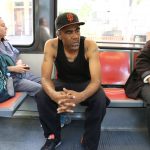Part of a special report on homelessness and mental health in San Francisco, in the fall 2014 print edition. Stories rolling out online throughout the fall.
People whose mental illnesses have made them homeless have a hard time getting the disability benefits they are owed, in part because they may lack the mental organization to advocate for themselves and navigate the complexity of the system. At the Social Security office, they face long waiting times and red tape. Application reviews can take months.
This year, Social Security completed a pilot program, launched in 2012, that gives homeless people with schizophrenia presumptive qualification for Supplemental Security Income benefits. The program, pioneered in San Francisco and a handful of other California cities, essentially puts these people at the head of the line.
With the end of the experiment in April, some social service agencies were left wondering whether the valuable service would continue.
The Homeless With Schizophrenia Presumptive Pilot Demonstration allowed staff to quickly make an initial diagnosis of schizophrenia. Those enrolled in the program received Social Security benefits within 10 days, rather than experiencing a wait time of six months or longer.
Staff at the San Francisco Department of Public Health and Human Services Agency identified clients and helped them complete applications for benefits. Conard House, a nonprofit homeless support agency, became a “representative payee” for the clients, helping to manage their finances.
Richard Heasley, executive director of Conard House, said one participant in San Francisco, who had been homeless for 15 years without any financial assistance, applied through the program, received immediate benefits and then permanent eligibility within six months.
In San Francisco, all 78 participants in the demonstration project received presumptive payments. Of those, 68 were awarded permanent benefits.
The project started in San Francisco and Santa Cruz, and expanded to Los Angeles.
Thomas Neill, director of client health services for the city’s Human Services Agency, said the pilot program made a crucial difference for a vulnerable population.
“If you have somebody with a serious mental disorder, they’re likely not in a stable living situation,” Neill said. “Perhaps they’re homeless, living on the street or in a shelter. They’re under greater stress, they’re more likely to decompensate and have greater difficulty following through and completing the application.”
If people facing those circumstances can get approved for presumptive benefits and housing, it becomes easier for agencies to assist them, and they are more likely to follow through with applications for permanent benefits, he said.
In California, benefits from Supplemental Security Income — the program that pays disability income benefits based on financial need — amount to about $900 monthly. That is roughly double the benefits offered by San Francisco’s own cash benefits program.
Social Security disability beneficiaries need to pay either a percentage of their payments or a fixed amount toward housing. Under San Francisco’s nearly decade-old Care Not Cash program, most of the city’s monthly cash benefit of $461 goes back to the city to provide housing. The cash portion comes to just $59.
Social Security expects to complete its evaluation of the pilot program in early 2015, said Patricia Raymond, a spokeswoman for the agency’s San Francisco regional office.
Barbara Garcia, director of San Francisco’s Department of Public Health, said at a hearing on homelessness early this year that city agencies prodded U.S. officials to start the program.
“It took seven years for the federal government to acknowledge that those with schizophrenia would have a hard time getting through our system,” including all the paperwork needed to attain benefits, Garcia said.
But she expressed hope that if the program succeeds in San Francisco that it “is also shared throughout the country.”
The collaboration with nonprofit social service organizations to hold the money for clients would have been valuable for Kim Knoble, who after a long period of suffering, recovered and for a while was a peer educator with the Mental Health Association of San Francisco.
When Knoble was living on the streets of the Tenderloin, she often spent her Social Security disability benefits on a shopping spree or a hotel room for the night — leaving her penniless for most of the month.
“I was manic, so I wasn’t even able to understand that you’re supposed to hold the money and spend it on resourceful items, as opposed to blowing it, which is what I did,” Knoble said. “Many months, I didn’t have shoes on my feet.”
Now, her life is stable and she has a full-time job.
This special report on homelessness and mental health in San Francisco, in the fall 2014 print edition, was supported in part by the Fund for Investigative Journalism.
Order the entire full-color, printed version through the website, or become a member and get every edition for the next year.









